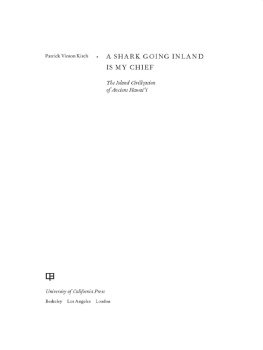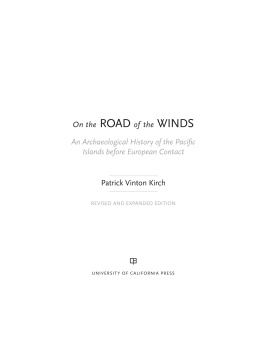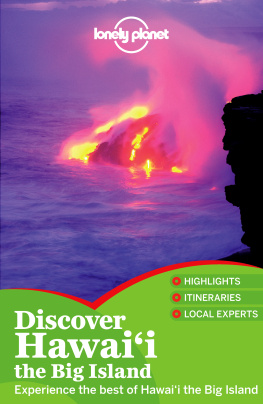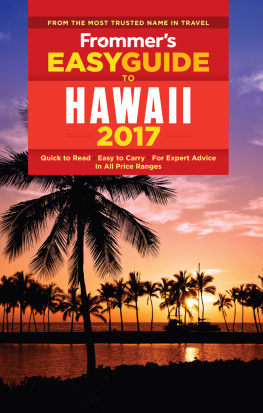Kirch - Shark Going Inland Is My Chief: the Island Civilization of Ancient Hawaii
Here you can read online Kirch - Shark Going Inland Is My Chief: the Island Civilization of Ancient Hawaii full text of the book (entire story) in english for free. Download pdf and epub, get meaning, cover and reviews about this ebook. year: 2012, publisher: University of California Press, genre: Non-fiction. Description of the work, (preface) as well as reviews are available. Best literature library LitArk.com created for fans of good reading and offers a wide selection of genres:
Romance novel
Science fiction
Adventure
Detective
Science
History
Home and family
Prose
Art
Politics
Computer
Non-fiction
Religion
Business
Children
Humor
Choose a favorite category and find really read worthwhile books. Enjoy immersion in the world of imagination, feel the emotions of the characters or learn something new for yourself, make an fascinating discovery.
- Book:Shark Going Inland Is My Chief: the Island Civilization of Ancient Hawaii
- Author:
- Publisher:University of California Press
- Genre:
- Year:2012
- Rating:4 / 5
- Favourites:Add to favourites
- Your mark:
- 80
- 1
- 2
- 3
- 4
- 5
Shark Going Inland Is My Chief: the Island Civilization of Ancient Hawaii: summary, description and annotation
We offer to read an annotation, description, summary or preface (depends on what the author of the book "Shark Going Inland Is My Chief: the Island Civilization of Ancient Hawaii" wrote himself). If you haven't found the necessary information about the book — write in the comments, we will try to find it.
Kirch: author's other books
Who wrote Shark Going Inland Is My Chief: the Island Civilization of Ancient Hawaii? Find out the surname, the name of the author of the book and a list of all author's works by series.
Shark Going Inland Is My Chief: the Island Civilization of Ancient Hawaii — read online for free the complete book (whole text) full work
Below is the text of the book, divided by pages. System saving the place of the last page read, allows you to conveniently read the book "Shark Going Inland Is My Chief: the Island Civilization of Ancient Hawaii" online for free, without having to search again every time where you left off. Put a bookmark, and you can go to the page where you finished reading at any time.
Font size:
Interval:
Bookmark:
ACKNOWLEDGMENTS
This book encapsulates the fruits of a lifetime of research. Over nearly five decades, my life as a student and scholar of Hawai'i and Polynesia has benefited from the help and generosity of mentors and teachers, colleagues and collaborators, students, friends, and acquaintances. To list them all would be impossible; I can only single out a few whose role cannot go unmentioned. Yoshio Kondo had the temerity to take a thirteen-year-old Punahou student into his summer program at the Bishop Museum, thus launching my career in science. To Kondo I will forever owe the ong about which he spoke so often with reference to his own mentor and patron, malacologist C. Montague Cooke Jr. Kenneth P. Emory, Yoshiko Sinoto, Lloyd Soehren, Marion Kelly, William (Pila) Kikuchi, Peter Chapman, and others of the Bishop Museum's archaeology program gave me early opportunities for field research in Hawai'i during the 1960s, as did Richard Pearson of the University of Hawai'i. Douglas E. Yen and Roger C. Green, then also of the Bishop Museum, encouraged my early efforts and helped to enable my transition from student to professional researcher. Yen and Green later became close colleagues and collaborators; many of my ideas were formed out of discussions, arguments, and debates with them.
Numerous individuals have contributed to my several major Hawaiian research projects. In our early work in Hlawa, Moloka'i, Tom Riley and Gil Hendren shared the excitement and challenges posed by that remarkable valley. Pilipo Solotario opened his family home in Hlawa to us and shared his deep insights into the valley's traditions. Charles Pili Keau worked with me at several sites on Maui, imparting his manao regarding Hawaiian culture and protocol along the way. Marshall Sahlins graciously invited me to collaborate on research in the Anahulu Valley, O'ahu, sharing with me his vast knowledge of Hawaiian and Polynesian ethnohistory. Dorothy Barrre, a collaborator in the Anahulu project, shared her boundless comprehension of the Hawaiian Kingdom's archives. Marshall Weisler participated in the Anahulu excavations, and worked with me on the archaeological survey of Kawela and Makakupai'a, Moloka'i. Rose Schilt and Jeff Clark similarly managed extensive highway-corridor salvage archaeology projects under my direction at Waimea-Kawaihae and Kona, Hawai'i Island, adding greatly to our knowledge of that island's archaeology. In my long-term research at Kahikinui and Kaup, Maui, I have been aided by my Berkeley doctoral students Sidsel Millerstrom, James Coil, Lisa Holm, Cindy van Gilder, Kathy Kawelu, and Alex Baer. The members of Ka Ohana o Kahikinui, and especially Mo Moler, along with ranchers Pardee Erdman and Sumner Erdman, Bernie and Andy Graham, and Jimmy Haynes, and the Department of Hawaiian Home Lands are especially thanked for opening up those vast kua'ina lands to my research team. John Holson has been a stalwart field team member not only of the Kahikinui and Kaup projects, but during our challenging 2000 expedition to Kalaupapa, Moloka'i. Since 2001, I have learned a great deal from my collaborators in the Hawai'i Biocomplexity Project, especially Peter Vitousek, Oliver Chadwick, Shripad Tuljapurkar, Thegn Ladefoged, and Sara Hotchkiss. Julie Field ably directed our 20072009 fieldwork in Kohala, Hawai'i Island. Parker Ranch, Pono Holo Ranch, Kahua Ranch, and the State of Hawai'i Department of Land and Natural Resources opened their Kohala lands to our research team.
Others (living and deceased) to whom I extend my mahalo nui loa for assistance, shared fieldwork, exchange of data or ideas, or other kkua include Jane Allen, Melinda Allen, Emmett Aluli, Pia Anderson, Steve Athens, Pat Bacon, William Barrera, Alan Carpenter, Francis Ching, Carl Christensen, Steve Clark, Bonnie Claus, June and Paul Cleghorn, Sara Collins, Ross Cordy, Neal Crozier, Dorothe and Dave Curtis, Bert Davis, Mahealani and Glenn Davis, Michael Dega, Greg Dening, Boyd Dixon, Tom Dye, Tim Earle, Ben Finney, James Flexner, Sam Gon III, Ward Goodenough, Michael Graves, P. Bion Griffin, Jo Lynn Gunness, Rose Guthrie, Hal Hammat, Toni Han, Edward S.C. Handy, Sara Hotchkiss, Robert Hommon, Terry Hunt, Helen James, Sharyn Jones, Elaine (Muffett) Jourdane, Adrienne Kaeppler, Jennifer Kahn, Solomon Ka'ilihiwa, Betty Kam, Ray and Shiela Kawaiaea, Kathy Kawelu, Alison Kay, Michael Kolb, Eric Komori, Ed Ladd, Charlotte Lee, Sam Low, Steve Lundblad, Mark McCoy, Patrick McCoy, Holly McEldowney, Art Medeiros, Peter Mills, Gail Murakami, Buddy Neller, T. Stell Newman, Cordelia Nickelsen, Aimoku and Lehua Pali, Cedric Puleston, Debra (Connelly) Prentice, Storrs Olson, Jack Randall, Roland Reeves, Paul Rosendahl, Clive Ruggles, Laura Schuster, Will Shapiro, Warren Sharp, David Sherrod, John Sinton, Aki Sinoto, Matthew Spriggs, Donna and Leon Sterling, Elspeth Sterling, Harold St. John, Catherine (Cappy) Summers, Jillian Swift, Margaret (Makaleka) Titcomb, Myra Tomonari-Tuggle, Dave Tuggle, Randy and Victoria Wichman, and Alan Ziegler. If others have been omitted here, it is only because the passage of so many years has dimmed my memory, and I beg their forgiveness.
At the University of California Press, I thank Blake Edgar for his continuing editorial stewardship. Peter Mills went beyond the normal duties of an external reviewer, and his extensive suggestions greatly improved the final manuscript. David Cohen prepared the individual island maps.
Finally, my wife, Thrse Babineau, has been an endless source of inspiration throughout the long process of writingencouraging me, reading drafts and rewrites, offering suggestions on both content and style. It is a small token of my gratitude to dedicate this book to her.
ALPHABETICAL LIST OF
HAWAIIAN HISTORICAL
PERSONS
AKAHIAKULEANA Mother of Umi by Lloa, ruling chief of Hawai'i.
ALAPA'INUI Son of the Kohala warrior chief Mahiolole and his wife Kalanikauleleiaiwi, half-sister of Hawai'i Island king Keawe'ikekahiali'iokamoku. Alapa'inui became king over most of Hawai'i Island and repulsed an attempted invasion by Maui king Kekaulike.
EHUNUIKAIMALINO Ruling chief of Kona district on Hawai'i Island in the time of Umi.
HA'ALO'U Chiefess and widow of Maui king Kekaulike who was sent by Kamehameha to receive the oracle of the prophet Kapoukahi.
HAKA A descendant of Mweke and ruling chief of O'ahu in the fifteenth century. An evil ruler, he was overthrown and replaced by M'ilikkahi.
HKAU Son of Lloa with Pinea, he succeeded Lloa as ruling chief of Hawai'i in the mid sixteenth century. Hkau was deposed by his half-brother Umi.
HIKAPOLOA An early ruling chief of Kohala district, Hawai'i Island, and grandfather of Lu'ukia.
HOLO'AE High priest of Hawai'i Island during the reign of King Kalani'pu'u.
HO'OIPOIKAMALANAI A daughter of the Kaua'i ruling chief Puna, wife of Mo'ikeha, and mother of Kila.
HO'OLAEMAKUA Ruling chief of Hna district of Maui Island in the early seventeenth century. He was killed by Pi'imaiwa'a of Hawai'i during the war for succession to the Maui kingship between Lono-a-Pi'ilani and Kiha-a-Pi'ilani.
HUAPOULEILEI Ruling chief of Waialua district on O'ahu in the fifteenth century who fought against Kalaunuiohua of Hawai'i.
IMAIKALANI Ruling chief of Ka' and a famous warrior, he opposed Umi but was killed by Pi'imaiwa'a.
IMAKAKOLOA A ruling chief of Puna district, Hawai'i Island, who rebelled against Kalani'pu'u, and whose body was offered up by Kamehameha as a sacrifice on the temple of Pkini.
KA'AHUMANU Favorite wife of Kamehameha I, and kuhina nui (premier) during the reigns of Kamehameha II and Kamehameha III. She was born about 1773 and died in 1832.
KAHAHANA Succeeded Kumahana as king of O'ahu in the late eighteenth century, until he was deposed and killed by Maui king Kahekili.
KAHA'I-A-HO'OKAMALI'I A grandson of Mo'ikeha, he made one of the last round-trip voyages to Kahiki, returning with the first breadfruit to be introduced to Hawai'i.
Next pageFont size:
Interval:
Bookmark:
Similar books «Shark Going Inland Is My Chief: the Island Civilization of Ancient Hawaii»
Look at similar books to Shark Going Inland Is My Chief: the Island Civilization of Ancient Hawaii. We have selected literature similar in name and meaning in the hope of providing readers with more options to find new, interesting, not yet read works.
Discussion, reviews of the book Shark Going Inland Is My Chief: the Island Civilization of Ancient Hawaii and just readers' own opinions. Leave your comments, write what you think about the work, its meaning or the main characters. Specify what exactly you liked and what you didn't like, and why you think so.









